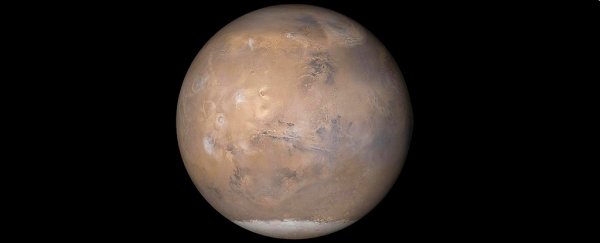Not so long ago, Mars had a bunch of methane in its atmosphere. And then it didn't.
Either a whole lot of research is just plain wrong, or we have one heck of a mystery on our hands. Coincidentally, while one group of researchers double checked their sums, other researchers have stumbled on results that could lead to an answer.
A sneak peek at data gathered by the ExoMars Trace Gas Orbiter (TGO) late last year suggested its survey on methane levels in the atmosphere early in 2018 didn't agree with observations made by the Curiosity rover in late 2013 and early 2014.
Now we can confirm that it wasn't some sort of error on either team's part. It's official, the numbers don't line up.
After accounting for possible noise in the data, any methane that might happen to be floating around on Mars today has to be at least 10 to 100 times lower than previous estimates.
That suggests a whole lot of methane dropped out of the sky in recent years. Only problem is, nobody has the foggiest on what might cause such a rapid vanishing act.
Curiosity might have gotten it wrong, of course. It had reported finding nothing previously, and being stuck close to the ground isn't a great spot for a rover trying to describe the atmosphere.
But Curiosity's error is incredibly unlikely. The European Space Agency's Mars Express mission also caught a brief whiff of the gas, after all. Back in 1999, ground-based telescopes on Earth also captured signs of methane in light reflected from the planet.
If past efforts could be considered the work of amateur methane sniffers, TGO is a pro. Sadly, coming up empty handed is a serious concern given its ability to sift out 50 parts of methane per trillion.
Dismissing possibilities of an error, researchers are left with a mystery to solve.
One tantalising suspect for the here-one-day-gone-the-next hydrocarbon is the record sized dust storm that swept across Mars last year. It was a doozy, too. Just ask poor old Opportunity, the rover we all mourned in February after dust prevented it from recharging its batteries.
Wild weather events on Mars are rare. When winds do whip up on the dusty red planet, they can affect the atmosphere for months, occluding sunlight and affecting temperatures around the globe.
This has a knock-on effect where water vapour can build up in the upper atmosphere, especially towards the poles. Taken together, these changes in chemistry, sunlight, and temperature can potentially affect a range of atmospheric reactions.
Astronomers had never seen anything quite like the 2018 dust storm, so it was fortunate that TGO was keeping watch.
While one team of researchers were looking for signs of methane in the instrument's data, another was working out the ratio of two types of water in the air.
All water is made of two hydrogens and an oxygen. But those hydrogen atoms can come in several flavours, including a slightly heavier version called deuterium, made of a proton and a neutron.
Before the storm, there wasn't a lot of this deuterium-based water floating around in as vapour above an altitude of 40 kilometres. So little, in fact, they couldn't detect it. What they did see were plenty of water-ice clouds.
Once the storm hit and stirred things up everything changed rather quickly. Those ice clouds evaporated and levels of heavy water in the upper atmosphere went sky high.
For researchers interested in the water cycle on Mars, this is important information. The ratios of heavy and 'normal' water have a lot to say about how water breaks down and blows into space.
But reading between the lines, it also provides an example of the kinds of dynamic forces unleashed by churning dust and gas as storms scour the planet's surface.
It's far too early to hold the 2018 storm accountable for the lost methane. But it's not exactly a bad place to start looking, either.
Whatever mechanism was responsible for the discrepancy, it needs to be 1,000 times faster than any chemical reaction we can come up with.
No doubt all eyes will remain on Mars in coming years to keep a careful eye on those methane levels. Something is going on up there, and we're desperate to know what it is.
